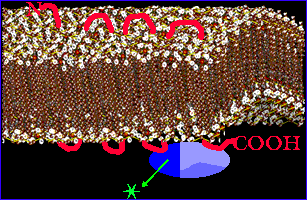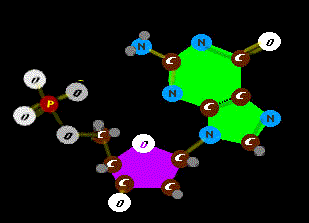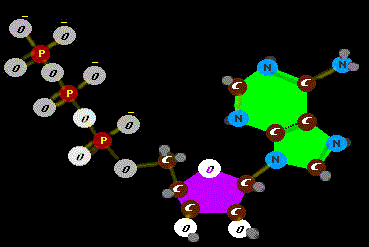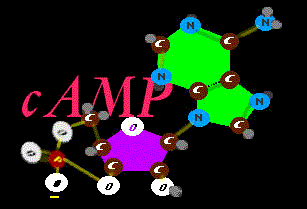
Warning - deep stuff - for med students etc.
 Receptors - Details
Receptors - Details
There are a variety of cell membrane devices for action and interaction.![]()
The cell channels or pores are essentially grommets (sleeves that penetrate and line the penetration). A typical channel may be constructed like a wine barrel from side to side barrel staves. The channels for sodium, potassium, chloride and calcium are made up of 5 barrel staves bounding the central opening. The proteins that make up the pores have two jobs aside from opening and closing.
1) Be neighborly. Nestle into the three layer cell membrane such as to be welcome there. That is, the outer surface has to reflect the triple layer quality of the cell membrane in which it resides. Also be neighborly to the other staves of the barrel. The 5 units must fit edge to edge and create a single final unit.
Remember that the various amino acids have a wealth of individual properties. Some cause bending, some make rigidity, some have oily hair, some are wet-like etc. In the coiling of the protein the proper properties have to be in all the right places.
2) Be selective. Sodium (NA+) and Potassium (K+) have similar chemistries being in the same periodic column wherein the soft silvery white alkali metals typify the general. Specifics, however allow the group to be differentiated. At earthly hydrogen is a gas and nearly just a proton when sharing its one and only electron. Lithium (atm N = 3, wt = 6.9), sodium is larger (atm N = 11, wt = 23) and potassium larger still (atm N = 19, wt = 39). But charge density is what attracts water. These metal ions do not go around naked. They are bundled with strongly attracted water shells whose size depends on charge density.
Bottom line, the barrel is an electrical field and size sieve which excludes whatever is not wanted to pass. So there are specific chloride, sodium, potassium and calcium channels. When these channels open, there is not general entry or exit. Channels have receptor locations which when fitted by a molecule key, causes the channel to open.
![]()
Enzyme Receptors are another group of devices affixed in the cell membrane. Some just go straight through like a cufflink through a cuff. There may well be associated parts outside (like a diamond in the cuff link face) and inside (like the tilty spring of the link lock). When the outer thingy gets a tweak from something outside, the inner thingy by way of protein deformation gets its own tweak . As the inner portion may be packing (have a catalyst which it can shoot off), the outer portion may well be seen as a trigger.
![]()
 Similar, but just more structurally complex, G-Proteins are like serpents in the cell membrane. With 3 1/2
loops (that's 7 passes in and out), the Locked Nestling Receptor has its tail above (outside the cell). That's the NH3 end of the amino acid chain. The head of the monster
(-COOH) is beneath, looking for trouble. It traps a prize between its jaw and neck (last lower loop). That magical device (of three parts) will split off one majestic piece which will bring the dead to life.
Similar, but just more structurally complex, G-Proteins are like serpents in the cell membrane. With 3 1/2
loops (that's 7 passes in and out), the Locked Nestling Receptor has its tail above (outside the cell). That's the NH3 end of the amino acid chain. The head of the monster
(-COOH) is beneath, looking for trouble. It traps a prize between its jaw and neck (last lower loop). That magical device (of three parts) will split off one majestic piece which will bring the dead to life.
 The dead are protein systems waiting for energy (batteries are dead).
The dead are protein systems waiting for energy (batteries are dead).
What the majestic piece has is a guanosine triphosphatase thingy which splits off a phosphate from GTP to make GDP (GMP shown on left. GMP has one more PO4 and GTP has two more). This is the energy needed to temporarily free this piece which swings away to activate a nearby tool (an enzyme) which churns out cyclic ATP from ATP. Thus one GTP=>GDP set a stream of ATP=>cAMP in production. This is called amplification.
 That there are two forms of energy helps the cell regulate. The high energy of ATP get trapped in a spring loaded and very compact AMP - well suited to nestling into activation sites in enzymes
waiting for power.
That there are two forms of energy helps the cell regulate. The high energy of ATP get trapped in a spring loaded and very compact AMP - well suited to nestling into activation sites in enzymes
waiting for power.
ATP is shown on the left. Note the adenosine which distinguishes it from guanosine (previous image).
In many enzyme systems, the power sought is not just grabbed from anywhere. Thus think of these enzyme systems as assembly lines. What would these
assembly lines do when turned on as powered by cAMP?
Thus think of these enzyme systems as assembly lines. What would these
assembly lines do when turned on as powered by cAMP?
For one thing, pump. Cells need to reset the conditions that were in place before the inpouring. Sodium pumps, potassium pumps, calcium pumps, chloride pumps, and other stuff require energy to move atoms against the concentration gradients. That is - to create unique environments and sustain them.
In each case - Pores, Cufflinks, or Serpents - there is a trigger location which when activated by the right key, sets the action going. So the pores have an outer tag that may cause the pore to open and expose its unique filtering channel.
That's where drugs come in. A skeleton key may fool the receptor to activate. Or, it may just plug the receptor and make the mechanism unavailable.
![]()
Cells have internal membranes as well which maintain internal subcellular environments. Therefore the above applies to subcellular pores and transport mechanisms. Caffeine is a skeleton key which fools an intracellular calcium (Ca++) channel. Vitamin D acts on an intracellular receptor, as do certain other steroids (Vit D is pretty close, structurally, to being a steroid). Thyroid hormone also acts this way. In these cases the membrane is nuclear and the receptors act on DNA itself.
Receptors are named - for the most part - after the common substances which were most effective in activating them. Like calling a kid scaredy-pants instead of Thomas Carlington Wentworth III. The names do not reflect the biologic pedigree of the receptor but rather the evident behavior.
Amino Acid Receptors, Nicotinic Receptor, Muscarinic Receptor, Adrenergic, Prostaglandinic, Histaminic, and Others.
![]()
Amino Acid Receptors are sensitive to glycine, glutamic acid, aspartic acid, gamma amino butyric acid (GABA), and taurine. These are the work horse relays in the central nervous system .
GABA is the handy dandy signaling chemical of the reticular system. That is the complex that nestles near the central core of upper spinal cord and brain stem. It throws fibers toward higher structures like a tree. The reticular system is INHIBITORY. Concentration - huh? you were talking to ME? - is the turning OFF of function not critical to the thing of interest. Distraction is inability to ignore or repress. A drug that turns off the ability to pick and choose what is attended to - like LSD - will flood the senses indiscriminately and relationships will lose boundary and melt together and make song writers say peculiar things. GABA is the chemical that activates channels which cause nerves to hyperpolarize (higher than normal charge) and thus harder to activate (depolarize). A typical GABA action is to open chloride pores and let chloride (and only chloride) in. Substances which also open this pore or which cause GABA to act longer or stronger include diazepam (Valium) and several drugs which share a very similar outer shape. The actions are what are expected: less anxiety, slowed reaction time, disinhibition, bad math, machinery run amok, staggering etc.
A defect in the reticular system to adequately supply inhibitory circuits or enough GABA is the basis for hereditary forms of epilepsy. Thoughts are kept alive by circuits recycling. But they may recruit and spread unless tamed. Deficient inhibition, those brain regions with more recycling circuits are more apt to become seizure sources (self recruiting and spreading by recruiting as intensity amplifies). In a very real sense an obsessive thought may be seen as a recycling disinhibited focal process without spread.
Therefore, a listing of anxiety drugs reveals drugs that impact on general awareness states. This is NOT depression, as nothing is neurologically depressed in depression but rather it represents a state of stereotypic negative interpretation and reaction irrespective of and layered upon reality. Those states are also related to brain circuits with high degrees of cyclic structure.
One such system is the limbic system. That is a very basic and tangled series of interconnecting structures which mediate fear, anxiety, sexual tension, -- all the good stuff -- and smell to a degree. In the absence of GABA sufficiency, this system can run amok quite easily. A seizure with intense odor perceived may well reside here.
![]()
Nicotinic Receptor - Muscarinic Receptor - Acetylcholine is a neurotransmitter with two main receptors. One can be activated by nicotine and the other by a mushroom poison called muscarine.
These nicotinic channel mechanisms are built on the five staves barrel plan - with some variation in the autonomic circuitry. The nicotinic reactive ones pass sodium or potassium. The muscarinic receptors are built on the serpent model. By far, most of the acetylcholine receptors in the central nervous system are this serpent type. The serpent type, as you recall, sets an active process going - a battery driven series of processes. These can PUMP and go against the flow. They are slower but more sustained than just opening a flap to a hole that quickly shuts. Drooling from excessive salivation is a muscarinic effect. A drooling pinhole iris blinded person from food poisoning needs atropine - the blocker of this receptor.
Acetylcholine is broken down by an enzyme called cholinesterase. That is important or else the acetylcholine will just keep on stimulating its receptors and act as the poisons do, not having an enzyme to destroy them on the handy. Agents that bugger cholinesterase allow acetylcholine to just sit there acting much as poisons do active active active active.... These drugs are called nerve gas. Sarin is in this category.
Atropine, by blocking the muscarinic receptors turns a whole bunch of things off. Belladonna - a drug whose name means beautiful woman - was so called as it was thought that women with dilated Irises (a reaction that means - ooooohhh, you are soooooo interesting to me) and who were bouncing off the walls unable to focus, were thought to be pretty. So, knowing that the active agent in belladonna is atropine (pretty women don't spit either), helps you remember that atropine turns off salivation, dilates the eyes, and stops all that sweating.
Pretty or not, this is useful stuff for anesthesia. For these reasons plus the slowing - be still my heart - of the heart rate, atropine is used for surgery rather often. A very similar drug to atropine is scopolamine. Scopolamine is very very much like atropine but actually in degree of effects is safer and easier to get just right. Just one draw back. It makes you outright loony toons. It was used not that long ago as a safe agent in pregnancy and labor. The ladies with their beautiful eyes and puckered dry mouths wore football helmets so they wouldn't hurt themselves in their crazed ranting scopolamine states. That detracts a bit from the beauty aura, no? Oh, it is used in some over the counter sleeping pills! Really! Like there aren't enough nut jobs out there already.
![]()
Adrenergic Receptors - These are all serpent types. The adrenal gland makes epinephrine and norepinephrine which it dumps into the blood stream to broadly bolster certain states, such as vigilance and reactivity. They'll help you boldly go where you really ought not be going. These agents are also made at specific neuron junctions and used as specific neurotransmitters. There is a alphabeta of known receptor types that respond to these neurotransmitters: alpha 1, alpha 2, beta 1, beta 2.
alpha 1 - vasoconstriction to stop bleeding, decongest the sinuses.
alpha 2 - increase sympathetic nerve actions - raises blood pressure.
[ alpha = 1 clot, desnot, 2 give it all you got]
beta 1 - stimulate the heart, make the heart rate go up
beta 2 - relax smooth muscle, open asthmatic breathing apparatus, slow labor (uterine).
[beta = 1 beat faster, 2 breathe deeper, keep the baby in the keeper]
Propranolol is a beta (1 & 2) blocker. There are many drugs for tweaking these receptors more specifically. One is so specific to be dubbed the musicians blocker, as it removes the tremor of stage fright with less cardiac consequences. But notice that the beta 2 effects of asthma protection must be considered when using beta antagonists in asthmatics.
![]()
Prostaglandinic - These are serpentine receptors. There are a wide array. This group reacts to the by products of arachadonic acid - a fatty acid plucked from the cell membrane itself as a source material. This was already discussed in the anesthesia introduction. The effects of this group as a group of transmitters acting on their receptors is to vasodilate, bronchodilate, dump salt and water, and hold on to fuel (slow down the metabolism of glucose and fat and the release of fat), aggregate platelets, and something mmm presidential? - an easily breathing light headed fat man who has wet his pants over being cut but not bleeding (sorry, that was the best - worst - mnemonic I could muster).
![]()
Histaminic - Three serpentine receptors H1, H2 and H3 are known. H1 is in smooth muscle. H2 is in the gastric lining, heart muscle. H3 in certain gut neural cells. All three are also receptors of neurotransmission in the nervous system. Now you know that ANTI-histamines make you sleepy. Soooo? These are excitatory. Histamines specifically, at the periphery, increase sensory irritability and make pain information easier to transmit. Histamine sensitizes. Histamine increases gastric acid secretion. It is released in states of stress. Stress ulcers go by many names. Each specialty has an esophageal or other ulceration syndrome named after a practitioner which indicates that that particular disease state can bring about serious ulceration. So we have Curling's ulcers, and Cushing's ulcers and so on. Zantac (ranitidine) has been so broadly used in preventing this complication that anyone in the medical field knows what is meant by including vitamin-Z in the post op or post trauma medications. There are, of course, others.